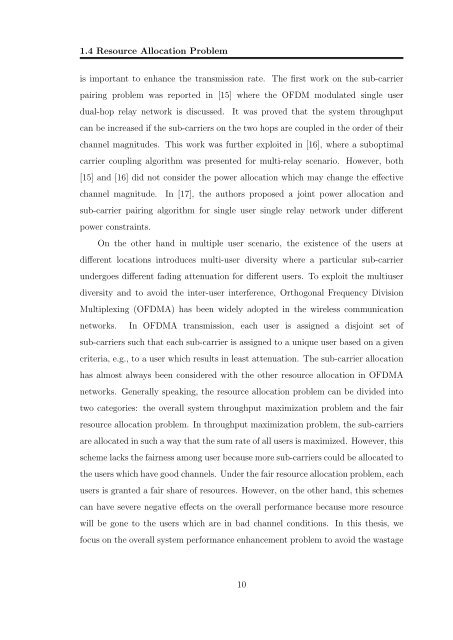Resource Allocation in OFDM Based Wireless Relay Networks ...
Resource Allocation in OFDM Based Wireless Relay Networks ...
Resource Allocation in OFDM Based Wireless Relay Networks ...
Create successful ePaper yourself
Turn your PDF publications into a flip-book with our unique Google optimized e-Paper software.
1.4 <strong>Resource</strong> <strong>Allocation</strong> Problem<br />
is important to enhance the transmission rate. The first work on the sub-carrier<br />
pair<strong>in</strong>g problem was reported <strong>in</strong> [15] where the <strong>OFDM</strong> modulated s<strong>in</strong>gle user<br />
dual-hop relay network is discussed. It was proved that the system throughput<br />
can be <strong>in</strong>creased if the sub-carriers on the two hops are coupled <strong>in</strong> the order of their<br />
channel magnitudes. This work was further exploited <strong>in</strong> [16], where a suboptimal<br />
carrier coupl<strong>in</strong>g algorithm was presented for multi-relay scenario. However, both<br />
[15] and [16] did not consider the power allocation which may change the effective<br />
channel magnitude. In [17], the authors proposed a jo<strong>in</strong>t power allocation and<br />
sub-carrier pair<strong>in</strong>g algorithm for s<strong>in</strong>gle user s<strong>in</strong>gle relay network under different<br />
power constra<strong>in</strong>ts.<br />
On the other hand <strong>in</strong> multiple user scenario, the existence of the users at<br />
different locations <strong>in</strong>troduces multi-user diversity where a particular sub-carrier<br />
undergoes different fad<strong>in</strong>g attenuation for different users. To exploit the multiuser<br />
diversity and to avoid the <strong>in</strong>ter-user <strong>in</strong>terference, Orthogonal Frequency Division<br />
Multiplex<strong>in</strong>g (<strong>OFDM</strong>A) has been widely adopted <strong>in</strong> the wireless communication<br />
networks. In <strong>OFDM</strong>A transmission, each user is assigned a disjo<strong>in</strong>t set of<br />
sub-carriers such that each sub-carrier is assigned to a unique user based on a given<br />
criteria, e.g., to a user which results <strong>in</strong> least attenuation. The sub-carrier allocation<br />
has almost always been considered with the other resource allocation <strong>in</strong> <strong>OFDM</strong>A<br />
networks. Generally speak<strong>in</strong>g, the resource allocation problem can be divided <strong>in</strong>to<br />
two categories: the overall system throughput maximization problem and the fair<br />
resource allocation problem. In throughput maximization problem, the sub-carriers<br />
are allocated <strong>in</strong> such a way that the sum rate of all users is maximized. However, this<br />
scheme lacks the fairness among user because more sub-carriers could be allocated to<br />
the users which have good channels. Under the fair resource allocation problem, each<br />
users is granted a fair share of resources. However, on the other hand, this schemes<br />
can have severe negative effects on the overall performance because more resource<br />
will be gone to the users which are <strong>in</strong> bad channel conditions. In this thesis, we<br />
focus on the overall system performance enhancement problem to avoid the wastage<br />
10

















